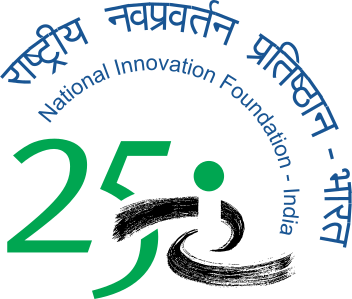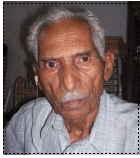Mere haathon se hamesha kuch naya hona chahiye2?, observes Shamrao, with a restless tone. Shamrao Parhate (76),a fabricator-cum-mechanic,is a multidimensional serial innovator par excellence who over the years has produced numerous useful innovations. Shivraj multipurpose agricultural equipment is one such implement, which shows his immense talent to fabricate things as per the users? needs and requirements.
He is the patriarch of a family of thirteen including his wife, sons and their families. Two of his sons run a fabrication workshop while the third one works in a company exporting small rubber items used in medicinal packing. The agricultural equipment developed by him, is named after his son, Shivraj. Due to financial constraints, Shamrao could not study beyond fourth standard. He learnt ?watch repairing? from his father at a young age and started assisting him. Since there was not enough work for both of them, he started taking training in photography at the age of 22 and thereafter started working as a professional photographer. He had to travel extensively for work. He felt fatigued as the traveling increased and finally stopped photography, to start a radio workshop along with his watch workshop. Over the next few years, he worked in his 10? by 20? shop engaged in watch and radio repair, wishing to start a workshop of his own. Recognizing his keenness, a local businessman, Sardar Satwant Singh helped him by loaning him the equipment. Despite not having any formal training, he developed his acumen by working on diverse kind of machines.He worked round the clock in his shop for about 16 years. Owing primarily to his efforts, in 1969, the government sanctioned a large plot for an industrial cooperative. Parhate started his workshop there, initially on a smaller portion of this plot.. Now, he has two workshops under the banner of Parhate Engineering Industries in the same area.. His sons have joined him in running it. In 1974, an American Educational Institute presented an X-ray machine to the Vidharbha College, Amravati in Maharashtra. During transit from Mumbai to Amravati, the water circulation force pump from the machine was stolen. Nobody knew about this and when the machine was started in Amravati, the X-ray tube worth approximately Rs.10,000 got destroyed. When they went through the operating manual they found that a pump was essential for proper functioning, which was absent.A letter was dispatched to the same company in US for the pump and the tube. The US Company was able to provide a new X-ray tube but could not send the pump. However, they sent the technical design of the pump with special consideration. The
design was sent to many companies but nobody could make it.Finally, Dr. Poddar, in-charge of Physics department in the College and a friend of Parhate, wrote a letter explaining their requirement and also sent technical drawings to him. He studied the drawings and then submitted a quotation to manufacture it. Within three months, Parhate readied and tested the pump,took it personally to Amravati and demonstrated it
successfully in front of the Professors. This was his first success.
In 1980, while working in his workshop, he met with an accident. He hurt an eye while welding, and had to undergo medical treatment for a few months. While recuperating he started working on developing a welding spark protector/welding helmet. After some work for a couple of months, he succeeded in making an automatic spark protector.
He wanted to patent it but did not know how to go about doing so. He went to a patent attorney who asked for a sum of Rs. 2,000 for filing patent, which he was unable to pay. He got a book on Patents and with the help of a friend read the relevant portions and based on the sample patent application forms, he submitted an application to the patent office in Mumbai in 1985. Due to his inexperience in drafting and language skills, the process continued with numerous correspondence letters seeking clarifications. Following this chain of communication between him and the patent office, he finally succeeded in patenting his device in April 1987.
While exploring the possibilities of commercializing this innovation, he learnt about a Taiwanese company, which manufactured such helmets, but
their helmet was semi-automatic. When approached by him, the company got interested in buying the technology for Rs. 5,00,000. The deal
did not get through as he realized that much of the money coming in would have to be deposited as tax to the Government. He finally settled for a lower amount by transferring the technology to a Mumbai based company.
Similarly, in 1988, when a Soyabean processing plant was set up near Pandhurna, a particular component?the rotary connector of a device ?Swip Agar? failed and the company?s engineers approached Parate. He made the component with such efficiency that it worked better than the original ones made in Japan.
After this, Pune based company Thermax, who have installed a plant in Pune along with other countries like Bangladesh, Malaysia, Pakistan etc., gave him bulk orders to manufacture this component for installation at various sites. He supplied the components to Thermax till 1993.
Parhate has led a life of constant exploration. His other innovations include technique to stop wobbling of wheels in four wheelers, modified drip irrigation system, energy generation through transportation, seed planter, welding rod holder and the versatile ?Shivraj? multipurpose device along with customized farm implements. In addition, he has developed an idea to generate electricity through unconventional means about which he refuses to divulge more until he has a patent for it.
Having a long development experience, he has this to say: ?Research karna hai bhai to himmat rakho. Asambhav ko sambhav banane mein kharcha to hota hi hain. Seed planter ka ek component jo teen rupaye ka tha, use banana ke liye, die ka kharcha sare barah hazaar aaya?3 Genesis
The innovator, living in the soyabean and cotton belt of Madhya Pradesh, observed that sowing, intercultural operation, weeding and harvesting were labour intensive agricultural operations. Scarcity of labour and high cost of operations done by mechanical power posed difficulty to small farmers. To address this issue, Parhate developed ?Shivraj? ? the multipurpose agricultural equipment in 2000. Being priced at Rs. 15,000 the machine could not find any takers.
Based on user feedback and his own insights, Parhate modified the design and came up with another prototype in about a year?s time. Since then
he has been constantly modifying design, as and when people come to him with specific demands. This effectively led to the evolution of the machine, ?Shivraj?. The present machine is the third version resulting from his constant effort for developing suitable product.
Innovation
The ?Shivraj? is a multipurpose tool frame drawn by paired bullocks. It is lightweight and can perform up to six agricultural operations. Different accessories can be attached to it for different operations like shallow ploughing, interculturing, weeding, sowing, residue collection, groundnut digging and soyabean harvesting. With modifications, it can also be used for spraying. It consists of a multi-purpose tool frame mounted freely on the central shaft of ground wheel to which accessories can be fitted: for example, the seed drilling attachment can be replaced by a sitting attachment.
The field capacity of the equipment is 0.27 hectare/ hour and the cost of this product with attachments for seeding, ploughing and interculturing is around Rs. 12,000.
The concept of multipurpose toolbar/frame used for ploughing, harrowing, sowing and intercultural operations for agricultural machineries, is well
known4 . IARI, New Delhi, has developed an integral tool bar that can do five operations viz. ploughing, harrowing, bund forming, ridge making and sowing and costs Rs. 3,800/-5.
Similarly, Tropicultor developed by ICRISAT, Hyderabad can be used for ploughing, stubble removing, planting and fertilizer application,
interculture operation and harvesting of turmeric and groundnut. It has a mechanical linkage to lower down or raising the attachment during turns or wherever required and costs about Rs, 40,000/- 6 . US Patent No. 5267517 (Dec. 7, 1993) describes a multi-function tillage or planting implement, which can be used for leveling, planting, compacting and chemical application in single pass.
However, ?Shivraj? has many innovative features:
It has a provision to vary RPM of the seedmetering unit and thereby allowing different seed rates and desired plant-to-plant spacing.
A thoughtful provision has been incorporated to disconnect seed metering drive using locking lever to avoid seed losses while taking a turn
in the field.
Provision has been made for changing the angle of penetration of soil-working tool during ploughing.
Another feature is a freely mounting frame on the central axis that allows lifted up of the device at turnings.
Specially built tyne type plough are provided. Three plough bottoms can be attached all at a time, full weight of machine is put into ploughing process and the angular back support ensures that plough does not bend when in use. Harrowing is done by steel tynes, which break the upper crust of the soil, uproot weeds, and pulverize the soil and mix soil and weeds. Residue is collected by a special attachment operated by a hand lever at the rear of this equipment. When the vehicle moves forward, it collects uprooted stalks, weeds and crop residue. When the lever is lifted, the collected material is dropped in to a heap to be carried away or burnt.
The seed drilling attachment consists of seed box, drilling unit, seed conveying PVC tubes and furrow openers. The drilling unit gets the drive from central shaft of driven wheels through belt and pulley mechanism. It can attach two to five furrow openers, as per need. Plant-to-plant distance can be varied from 4 to 20 inches (10 to 50 cms), by varying RPM of the drive and row-to-row distance can also be adjusted similarly.
Because of its high efficacy, cost of seed drilling using ?Shivraj? is less than half that of conventional bullock drawn seed drills. Weeding and intercultural operations are done by fixing suitable blades according to the need of crop being handled.
For groundnut digging, the groundnut-digging blade enters four to five inches deep in the soil, cuts the roots allowing the pods to be retained along with the plant. The working width of groundnut-digging blade is 8 inches (20 cm) and it covers one row in single run with facility to adjust angle of penetration of soil working tool.
For soyabean harvesting, an attachment drops the cut crop to one side for manual collection. A series of trials have been conducted on this
equipment, which has evolved over the years to deliver multiple functions seamlessly, and many units have been sold in the districts of Chhindwara, Nagpur and Wardha in Maharastra.The innovator has filed a patent application for this innovation.








